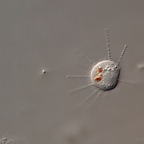WunderkanoneExploring the Microscopic World
Heliomorpha mutans (under the name Dimorpha mutans) was for a long time considered as part of the Heliozoans. Ultra-structural studies showed that the microtubule pattern of the axonemes is different from the other orders that are included in the Heliozoans. As recent phylogenetic studies have shown that Dimorpha is part of the Cercozoa – together with other amoeboids or flaggelates that use filose pseudopods to catch prey – Dimorpha has been renamed Heliomorpha (Cavalier-Smith & Bass, 2009).
Although Heliomorpha mutans doesn't appear very photogenic, it is a very interesting creature and difficult to photograph.



